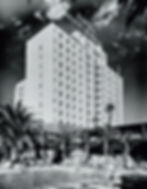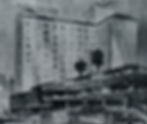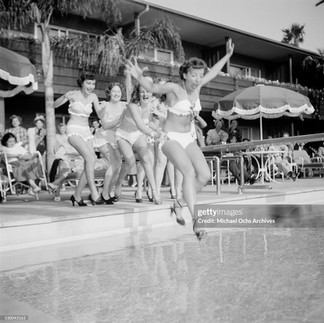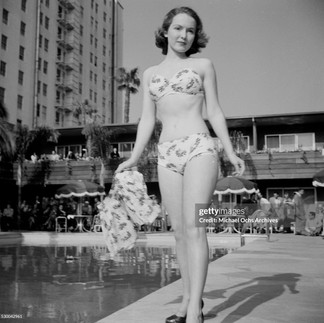Grand Opening of the Hollywood Roosevelt’s Pool
- KP
- Jul 4, 2024
- 3 min read
In the summer of 1950, the historic Hollywood Roosevelt expanded with a million-dollar tropical resort: The Promenade.

The Hollywood Boulevard hotel’s two-story annex is nestled in an exotic garden of Hawaiian flowers and towering palms with an eighty-foot swimming pool, outdoor barbecue, and snack bar. Colorful chaise lounges and matching umbrellas occupied the spacious sun-lazing area, laid in water-absorbent volcanic stone for poolside dancing.
To ensure year-round enjoyment, the tile-trimmed pool was heated, and at night, “daylighted” by 3600 watts of illumination.

Designed by architect Frank W. Green to resemble a South American luxury resort, the Roosevelt’s sixty-unit wing stresses the “freedom of movement” from room to pool area: floor-to-ceiling windows, draped in rattan, with gliding glass doors opening onto a private sundeck. Gently sloping ramps to the first and second stories facilitate room service.

The Promenade officially opened on June 16, 1950—and in true Hollywood fashion. Water samples from all of the oceans in the world were poured into the pool by airline hostesses, a nod at the Roosevelt’s prestige as an aviation headquarters.

The main event, Mack Sennett’s Girl of Today pageant, lured hundreds of pleasure seekers who filled the resort to capacity, overflowing into the second-floor balconies for a bird’s eye view of it all.
The bathing beauty show opened with a parade of swimsuit styles that had been in vogue between 1900 and 1950.
Contestants then slipped into modern bikinis and lined up on the diving board, as 70-year-old Sennett looked over each in search of his Girl of Today. He found her in aspiring actress Pat Hall—who was then pushed into the pool by the other ladies.
As it turned out, Bathing Beauty star and competitive swimmer Esther Williams had been invited to take the first dip in the Roosevelt’s pool, but alas, she was newly pregnant with her second child.
Eleven months earlier on July 13, 1949, Roosevelt owner Thomas E. Hull broke ground, ceremoniously operating a bulldozer beside his sister-business partner Sally Lewis Crofwell.
Hull—who purchased the hotel in 1934 from Joseph Schenck and Sid Grauman—told the press the resort’s completion was a “long-cherished dream to offer visiting tourists the color and romance they naturally expect to find in Hollywood.”

It marked the beginning of the Roosevelt’s “Parade of Progress” improvement program. Hull also remodeled the lobby and refurbished every room in the twelve-story hotel, then the largest in Hollywood. Among the new amenities: TV sets available for rental, “although it still is too early to know the full story on television,” Hull told the Los Angeles Mirror in 1949.

Four years later, he expanded and redecorated the famed Cinegrill, his first Roosevelt innovation. Originally a hotspot for 1930s Hollywood stars such as Bette Davis, Marlene Dietrich, and Humphrey Bogart, the new-and-improved Cinegrill became a favorite of Marilyn Monroe, who lived at the hotel in the early 1950s and even posed for photos on the pool’s diving board.

As part of the “Parade of Progress,” Hull also hoped to erect a twelve-story building west of the Roosevelt that would add another 300 guest rooms, plus an auto garage, radio-TV studio, and wedding chapel. On the roof, he imagined a skyroom for dining and dancing.
Ultimately, the idea was pared down to a four-story garage along Hollywood Boulevard and the addition of a 31-room block for the resort, designed by architect Stiles O. Clement (El Capitan, Pig ’N Whistle, Dr. Beauchamp’s dental office, Crane's showroom) in 1955.

Three-quarters of a century later, the Hollywood Roosevelt’s resort looks virtually the same (aside from a mural painted on the pool's floor by British artist David Hockney in 1988). Now known as the Tropicana, it remains a popular destination for tourists and locals alike looking to soak up the sun Old Hollywood-style.








































